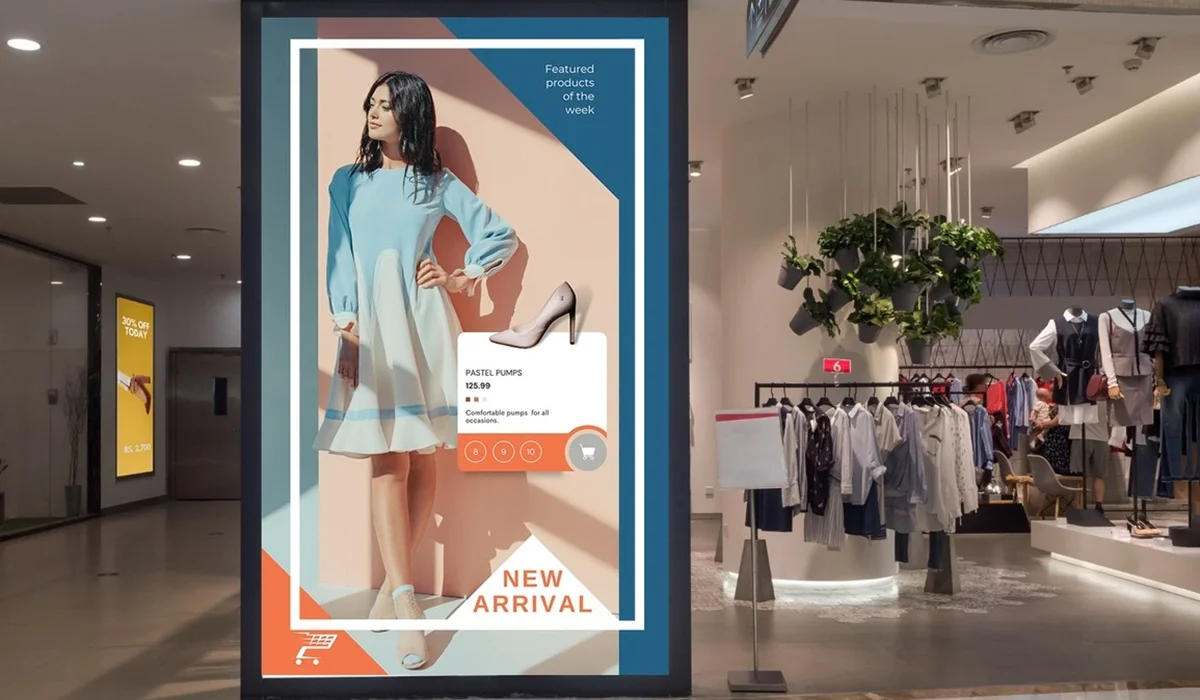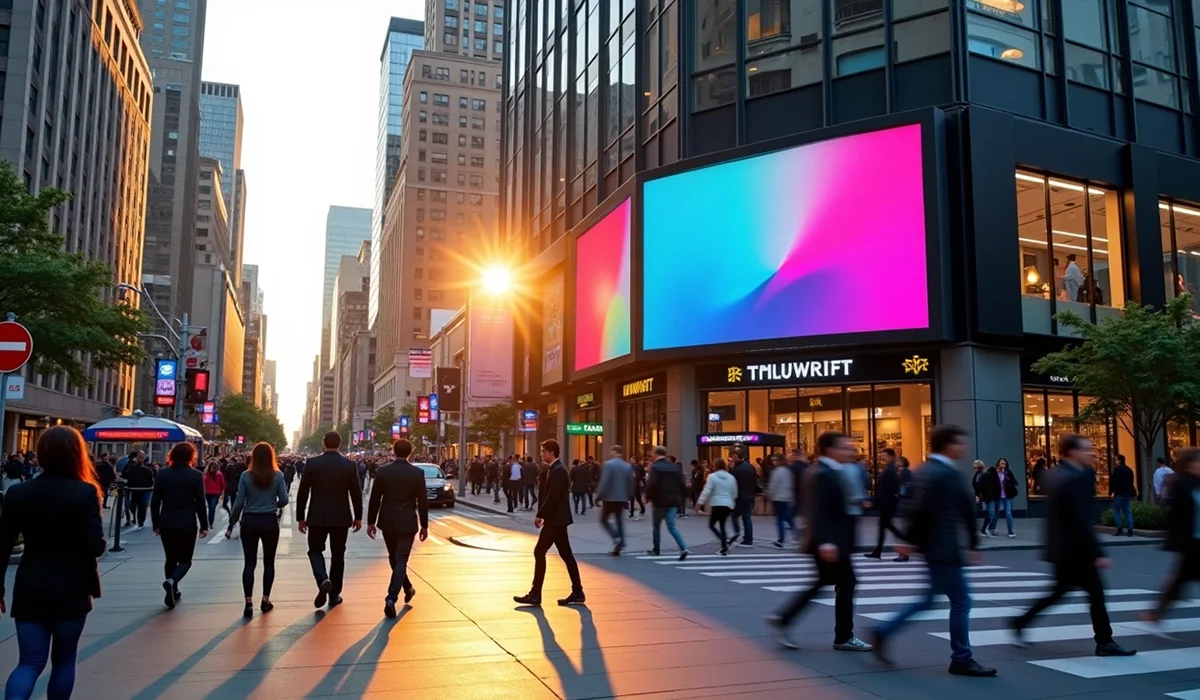Small businesses can save money substantially with digital signage solutions in their advertising campaigns. The Small Business Association reports that LED signs cost only 15 cents to reach 1,000 people. This cost is far less than newspapers ($7.39 per 1,000 people) and radio ($5.00 per 1,000 people). On top of that, digital screen advertising achieves an 83% recall rate, which doubles the effectiveness of traditional advertising methods.
Digital signage offers more than just cost benefits. Research shows that stores using displays attract 80% more customer visits. This technology serves as a powerful tool for small businesses that have tight marketing budgets. Your business performance can improve as digital signs help reduce customer’s wait time perception. They also provide economical ways to communicate key messages to your customers. This piece shows how digital signage can reshape your small business’s visibility and customer connections that boost your profits.
What is digital signage and why it matters in 2025
Definition and development of digital signage
Digital signage has grown from simple electronic displays into sophisticated communication platforms. These systems use screens to show dynamic content—including videos, images, and up-to-the-minute information—that users can update remotely. Digital displays catch people’s attention better than static signs through vibrant visuals, movement, and interactive features.
Digital signage started with simple electronic billboards replacing printed posters. These first versions could only show static images or pre-programmed messages. Technology advances brought LED screens, high-definition displays, and better content management systems. This led to richer and more engaging content delivery.
The year 2025 shows a complete shift from standalone screens to connected networks. Today’s digital signage systems come with cloud-based management, live data integration, and smart content delivery. The global digital signage market reached $26.76 billion in 2023. Grand View Research expects an 8.1% compound annual growth rate through 2030.
Why digital signage is important for small businesses today
Small businesses now see digital signage as a must-have competitive tool rather than a luxury. Research shows 60% of retailers without digital signage plan to invest in it within two years. American consumers are also 70% more likely to visit stores that use digital displays.
Digital signage gives small businesses several key advantages:
- Captures immediate attention: Digital screens with moving images, videos, and live updates make content more exciting and interactive than traditional signs. People process images faster than text and naturally notice movement and bright visuals.
- Provides agility and flexibility: Businesses can update content instantly and promote specials and events without printing costs. Customers always see current information, which improves their experience.
- Drives direct sales impact: Well-placed digital signs can shape buying decisions, create impulse purchases, and boost related product sales. Restaurants using digital menus can change items and prices quickly, which speeds up service and increases sales.
- Reduces operational costs: The initial setup costs pay off by eliminating ongoing expenses for printing, distribution, and installing traditional signs. Content updates take seconds with no extra cost, which helps businesses that run frequent promotions.
Small businesses can stand out from competitors with digital signage. This technology shows customers that a business thinks ahead and stays current. Digital signs create tailored customer experiences—a key factor in today’s market.
Digital signage does more than marketing. It helps internal communications, makes operations smoother, and provides data about customer engagement. Small businesses learn about customer behavior through these insights and can create better content that works.
Top 5 ways digital signage drives more sales
1. Captures attention with dynamic visuals
Digital signage grabs customer attention right away with moving images, animations, and vibrant visuals that static signs can’t match. Studies show digital displays get 400% more views than static ones. This visual pull comes from our brain’s natural tendency to spot movement—something psychologists call motion attraction.
The numbers speak for themselves. Dynamic digital signage boosts brand awareness by 47.7%. Higher awareness leads to more sales opportunities as customers remember what they’ve seen and become receptive to your products.
2. Promotes time-sensitive offers instantly
Small businesses love how they can update content immediately without the usual delays of traditional signage. No more waiting days for new print materials—you can push out flash sales, limited-time offers, and special promotions right away.
Quick updates create urgency. Countdown timers for flash sales or “limited stock” alerts push customers to buy quickly. A coffee shop might show iced drinks on hot afternoons and switch to hot beverages in the evening—all automatically without extra costs.
3. Reduces perceived wait times
Nobody likes waiting, but it’s part of retail and service businesses. Digital signage has a solution: engaging digital content makes wait times feel 35% shorter. Digital displays shift attention away from the wait and make time fly.
The results are clear. Digital signage cuts customer aggression by 50% and drops wait time frustration by 75%. Better customer experience means more sales—customers who stay engaged while waiting are 60% more likely to make last-minute purchases.
4. Encourages impulse buying through targeted content
Digital displays near checkout areas or busy spots create perfect impulse buy moments. About 20% of customers buy something unplanned after seeing digital signage. Eye-catching promotions work best when they appear right where customers make buying decisions.
Small businesses can tap into this by showing ads based on time of day, weather, or customer types. A retail store might highlight hot items or matching products based on that day’s sales. Timely, relevant content makes customers 68% more likely to buy advertised items.
5. Builds trust with consistent branding
Digital signage helps create a unified brand experience everywhere customers look. Central content management keeps your message and visuals consistent, which builds your brand’s identity. Customers trust businesses that stay consistent—and trust drives sales.
Digital displays do more than show brand elements. They can feature customer reviews and social media posts. Real customer stories create emotional bonds with potential buyers. Retailers using this strategy see sales jump by 33% on average.
How digital signage improves business performance
Successful digital signage brings powerful operational benefits that change how small businesses work. These technological advantages do more than attract customers—they transform basic business operations.
Real-time content updates and scheduling
Digital signage stands out from traditional methods because it creates and displays dynamic content. The content adapts based on location and customer priorities, which helps businesses provide current information to customers. Business owners can schedule content to appear on specific screens at set times. This creates a more streamlined content management process.
Digital signage lets businesses change displayed information right away. A restaurant can update its digital menu boards to show new specials or remove sold-out items without printing costs. This quick response will give customers a better experience and build trust.
Content updates happen on their own based on preset rules. A small retail shop can program displays to show morning deals before noon, afternoon sales until closing, and after-hours information overnight—without any staff help.
Remote management and control
Cloud technology has changed how businesses run their digital displays. Small business owners can update and control content from any place with internet access. A restaurant owner can change menu items during a supplier meeting. A store owner can update sales promotions from home.
The VXT Remote Management Solution shows these capabilities well. Users can control many screens at once from one place—whether they have two screens or hundreds. This central control removes the need for technical staff on site. Small businesses can focus on serving customers instead of maintaining equipment.
Remote management goes beyond just content. Business owners can:
- Set screens to turn on and off at specific times
- Update software across all screens
- Get alerts about possible technical problems
- Control power use to save money
Integration with social media and live data
Social media and data integration bring some of the biggest improvements to business performance. Screens can connect with social media platforms to show current posts and customer interactions. This social-first approach not only gets customers involved but also creates fresh content that updates on its own.
Digital signage changes how businesses make use of information. Companies in 2025 add real-time dashboards and performance tracking to their digital displays. These screens can show important data from many sources:
- Sales numbers and key metrics
- Stock levels and inventory updates
- Production goals and shipping details
- Customer engagement statistics
Research shows teams make better decisions when they can see performance data right when they need it. Production floors with digital displays showing real-time metrics have seen worker productivity jump by 86%.
The system can show different information based on specific triggers or limits. Screens might change colors to highlight delays, which draws attention to areas that need quick action.
Choosing the right digital signage solution for your business
Small businesses need to pick the right hardware and software components for their digital signage to succeed. Let’s get into the key factors you should think about when choosing a digital signage solution.
Hardware options: screens, kiosks, video walls
We started by choosing between consumer-grade and commercial-grade displays. Consumer TVs might seem budget-friendly at first, but commercial displays are a great way to get many advantages. They work longer (16/7 or 24/7), last longer, and usually come with better warranties.
The size of your screen makes a difference. Tablets work best for interactive kiosks or elevator displays. Larger monitors (32+ inches) create better visibility in main areas. Video walls that combine multiple screens can create powerful statements in busy areas.
Your choice of media player is significant. Here are your options:
- Consumer devices like Chromecast (affordable but don’t last as long)
- Commercial players like Yodeck’s Raspberry Pi solution (reliable for daily use)
- Industrial players with advanced features that handle tough environments
Software features to look for
Digital signage software should be easy to use and manage content well. Look for platforms that have drag-and-drop interfaces and customizable templates that make content creation simple.
Your software should include:
- Remote management to update content from anywhere
- Flexible scheduling for time-based promotions
- Support for different media formats and immediate data integration
- Tools to measure viewer engagement and results
The system needs security features like two-factor authentication and single sign-on options to keep your content and system safe.
Scalability and ease of use
Start small but choose a solution that grows with your business. Cloud-based platforms are more adaptable than on-premise solutions. You can add screens without spending much on extra infrastructure.
Yodeck’s approach works well—they give you a free plan for one screen, which helps small businesses start easily. Solutions that need less technical knowledge reduce your need for IT experts.
The right digital signage solution matches what you need now and what you’ll need later. This ensures your investment keeps paying off as your business grows.
Measuring ROI and optimizing your signage strategy
Setting up digital signage solves only half your challenges. Small businesses must have clear metrics to assess effectiveness and prove their investment’s worth.
Tracking engagement and dwell time
Your measurement strategy should focus on how audiences interact with displays. Visitor count metrics reveal the number of people viewing your content. The average dwell time shows how long viewers stay at your screens, which points to content relevance. Your daily session count helps calculate total customer interactions with digital signage.
Using analytics to refine content
Evidence-based decisions create stronger content strategies. Analytics tools help visualize performance through up-to-the-minute data analysis. A/B tests that compare different content versions show what appeals most to your audience. Customer feedback through surveys explains your content’s effectiveness directly.
Calculating return on investment
The ROI formula for digital signage is: ROI = (Total Benefits – Total Costs) / Total Costs × 100. Your baseline metrics before implementation serve as comparison points. The tangible benefits like sales increases or operational improvements should be calculated against total costs. Your business type doesn’t matter – regular ROI monitoring and strategy adjustments lead to optimal results.
Conclusion
Digital signage is changing how small businesses market themselves while keeping costs down. Our research shows this technology gets 400% more views than static displays and cuts down wait times by 35%. These numbers tell a powerful story.
Running a small business means competing with big companies that have deep marketing pockets. Digital signage helps level the playing field. Small businesses can now update content instantly, show eye-catching visuals, and merge with social media – things that traditional ads simply can’t match.
Making digital signage work takes a smart approach. Pick hardware that fits your business space and budget. Get software that’s easy to use and can grow with you. Set clear ways to track how well it’s working and measure your returns.
Small businesses that embrace this technology have a bright future ahead. Digital signage will keep getting better with AI, custom experiences, and new ways to interact. Businesses that start using it now will stay ahead of others stuck with old marketing methods.
Digital signage does more than just light up your space. It’s a powerful tool that makes customers happier, helps run your business better, and boosts sales. Every small business – from retail shops to restaurants to service providers – can use digital signage to connect with customers in amazing ways.
You can start small, but don’t wait too long. Your customers see dynamic content everywhere they go and expect the same from you. Digital signage delivers this experience while helping your business grow. The real question isn’t about affording digital signage – it’s about the cost of not having it.



